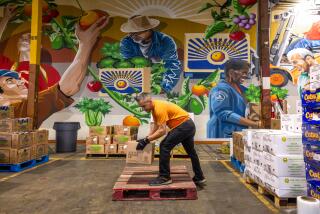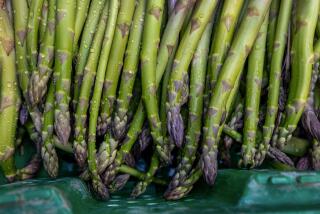Farmers, Consumers Find Markets Ripe
It is 10:29 a.m. on a recent Wednesday at Fullerton’s Woodcrest Park. Nearly 100 people have queued up quietly by the trucks parked beneath the trees. They are waiting for 10:30.
A bent woman with a scarf tied around her worried face waits. A woman in a leotard and sparkling tights waits. Gray-haired couples with shopping carts and young couples with toddlers wait.
At 10:30, a bell rings. Suddenly, the scene comes alive, as if a director had just yelled, “Action!” Voices rise in many languages. Money changes hands. Smiles grow as the throngs move from stall to stall, filling their carts, sacks and bags with their purchases--oranges, grapefruit, tangerines, vine-ripened strawberries and tomatoes, asparagus, avocados and more.
There are kiwi, kumquats, nuts and eggs. Turnips, snow peas and sprouts. Swordfish, snapper and shrimp. Begonias, pansies. . . and more.
The scene repeats every Wednesday at Woodcrest Park, 450 W. Orangethorpe Ave., the largest of three certified farmers markets held weekly in Orange County. The others are held Thursdays from 10 a.m. to 3:30 p.m. at the Orange County Fairgrounds, 88 Fair Drive in Costa Mesa, and Tuesdays from 9:30 a.m. to 2 p.m. at Hart Park, 701 S. Glassell St. in Orange.
Distinct from grocery stores called “farmers”’ or “ranch” markets, these state-regulated bazaars sell only what the vendors have produced themselves. Many fruits and vegetables are tree- or vine-ripened; some are organically grown and some are picked at sunrise the same day. Regular shoppers say they come early and wait in line because the produce is fresher--and often less expensive --than that which they find in conventional markets.
“I sell out in an hour at Fullerton,” said Ron Stephens, who sets up stalls at all the markets to sell strawberries ($3.50 for three baskets) grown by Dan Hashiba in Garden Grove. “These were picked at 5:30 this morning, ma’am,” he says, turning to a customer. “There’s not a green berry on the table. They’re very sweet,” he adds with a down-home nod and a wink.
“We come every other week. Everything is so fresh and so good,” said Dawnetta Rutledge of Fullerton as she and her husband, Craig, waited in line for broccoli. “We have lettuce here for the church luncheon,” she said, pointing to bags also filled with snapper, shrimp and shark. And, she added, “It’s a lot of fun just to come and see what they have.”
“We come every Thursday,” said Ali Nikzad at the Costa Mesa market. He had come during his noon lunch break with his mother, his wife and his 2-year-old son. “This is very cheap.” The market reminds him of the vans that bring produce to customers in his native Iran. He held up bags of strawberries, oranges, tangerines and lemons. “I have a family of five. This won’t last very long,” he said.
5 Kiwis for $1
At these markets, $1 can buy three pounds of vine-ripened tomatoes. Or five kiwis. Or a bag of oranges. Swordfish sells for $4.50 a pound, and a flat of pansies can be purchased for $7. Strawberries, just now coming into season, range from 50 cents a basket (for the misshapen or bird-picked) to $1.25 a basket for fresh, perfect berries.
In general, shoppers at Southern California certified farmers markets won’t save as much as those in other parts of the state because grocery store produce is less expensive here, said Vance Merrill-Corum, direct marketing specialist for the state Department of Food and Agriculture, whose regulations established the standards for farmers markets in 1977. But if the quality is better and the price equal, it’s still a good deal, he observed. “People have to judge.”
Growers commonly sold directly to buyers until four decades ago, when supermarkets introduced middlemen, he said. Direct buying --since then limited to roadside stands--has made a comeback during the past nine years as a result of a statewide cannery strike, he explained. Without the middlemen to package and sell their produce, farmers in northern California and Riverside set up three markets to sell directly to buyers in 1976. At the same time, there was a “public outcry” for the quality and savings offered by these farmers markets, and the following year the state set up its regulations to ensure only farmers--and not retailers--would sell at the markets, he said.
California now has 85 farmers markets operated by local government agencies, nonprofit organizations or producers. In Orange County, the Costa Mesa and Orange markets are run by the Orange County Farm Bureau. The Fullerton market, started by the American Assn. of University Women, is now run by a board of growers and civic leaders.
Free Directory
(The state Department of Food and Agriculture also publishes a free Farmer-to-Consumer directory each year listing the addresses of 1,200 farms that sell directly to the public. It may be obtained by calling 800-952-5272.)
Growers who take their produce to the markets are exempted from the usual sizing, grading and packing regulations but must abide by quality and maturity standards and any additional rules of the local management. Since the seller must be either the grower, an employee or a member of the family, shoppers have the chance to ask whether and which chemical sprays are used and to talk price, noted Merrill-Corum.
However, the Costa Mesa and Orange markets do not allow bargaining because it takes up too much of the farmers’ time, said Frank Bowring, the on-site manager of the markets.
It’s a hard practice to stop nevertheless. Masao Fujishige, an Orange County farmer, listened to a Costa Mesa shopper who told him his strawberries were five cents higher than those at another stall. “He only has half a basket,” said Fujishige shortly. “You know that. Don’t act so dumb.”
Producers compete in other ways. “A lot of business depends on if customers like you personally,” said Helen Miller, a retired math teacher who sells produce she and her husband, Jerry, a retired chef, grow on their three-acre farm near Lake Mathews. With their produce, the Millers hand out free recipes for such things as kumquat marmalade and cole slaw. They give children free honey on a Popsicle stick. And their products are organic.
Larger Growers
Although the markets are the only outlet for some small farmers like the Millers, larger growers come from as far away as the San Joaquin Valley to sell their surplus. They rent their stalls for 4 to 5% of their gross, which ranges between $50 and $1,000 a day.
Mark LaMorte, owner of Sunrise Greenhouses of Anaheim, said he can sell his extra plants in one day at the Fullerton market. He could sell them elsewhere, but it might take three trips, he said. His prices are sometimes below wholesale and on a typical day, he grosses $500, he said.
Although the markets offer a quintessential win-win situation for both farmers and consumers, about two dozen, including one in Santa Ana, have failed, said Merrill-Corum. Basically, they did not provide enough variety to attract consumers, he said. Key factors for success, he said, are advertising, a large variety of products and a good turnout on opening day.
With a balance between demand and supply, however, the market can become one of the most positive aspects of any community, he said. “There’s a sense of the market belonging to the people in the community,” he said. “It’s their community market, not just another profit-making produce market.
“The way people feel about the Fullerton market amply demonstrates that fact. I know people who will be loyal to that market for decades.”
Based on the number of applications he has received to start farmers markets, he predicted the total in California will reach 100 in the next few years.
More to Read
Eat your way across L.A.
Get our weekly Tasting Notes newsletter for reviews, news and more.
You may occasionally receive promotional content from the Los Angeles Times.








